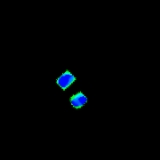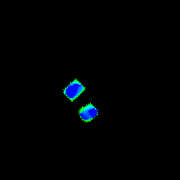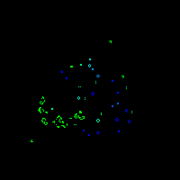
Life-like cellular automaton
Encyclopedia
A cellular automaton
(CA) is Life-like (in the sense of being similar to Conway's Game of Life
) if it meets the following criteria:
This class of cellular automata is named for the Game of Life
(B3/S23), the most famous cellular automaton, which meets all of these criteria. Many different terms are used to describe this class. It is common to refer to it as the "Life family" or to simply use phrases like "similar to Life".
, a decimal
number the binary representation of which has bits that correspond to each possible number of neighbors and state of a cell; the bits of this number are zero or one accordingly as a cell with that neighborhood is dead or alive in the next generation. The other two notations unpack the same sequence of bits into a string of characters that is more easily read by a human.
In the notation used by Mirek's Cellebration
, a rule is written as a string x/y where each of x and y is a sequence of distinct digits from 0 to 8, in numerical order. The presence of a digit d in the x string means that a live cell with d live neighbors survives into the next generation of the pattern, and the presence of d in the y string means that a dead cell with d live neighbors becomes alive in the next generation. For instance, in this notation, Conway's Game of Life is denoted 23/3.
In the notation used by the Golly open-source cellular automaton package and in the RLE format for storing cellular automaton patterns, a rule is written in the form By/Sx where x and y are the same as in the MCell notation. Thus, in this notation, Conway's Game of Life is denoted B3/S23. The "B" in this format stands for "birth" and the "S" stands for "survival".


 There are 218 = 262,144 possible Life-like rules, only a small fraction of which have been studied in any detail.
There are 218 = 262,144 possible Life-like rules, only a small fraction of which have been studied in any detail.
In the descriptions below, all rules are specified in Golly/RLE format.
Several more rules are listed and described in the MCell rule list and by , including some rules with B0 in which the background of the field of cells alternates between live and dead at each step.
Any automaton of the above form that contains the element B1 (e.g. B17/S78, or B145/S34) will always be explosive for any finite pattern: at any step, consider the cell (x,y) that has minimum x-coordinate among cells that are on, and among such cells the one with minimum y-coordinate. Then the cell (x-1,y-1) must have exactly one neighbor, and will become on in the next step. Similarly, the pattern must grow at each step in each of the four diagonal directions. Thus, any nonempty starting pattern leads to explosive growth.
`life-like' given in this article, because their neighbourhoods are larger than the Moore neighbourood, or
they are defined on three-dimensional lattices, or they use a different lattice topology. For example:
Cellular automaton
A cellular automaton is a discrete model studied in computability theory, mathematics, physics, complexity science, theoretical biology and microstructure modeling. It consists of a regular grid of cells, each in one of a finite number of states, such as "On" and "Off"...
(CA) is Life-like (in the sense of being similar to Conway's Game of Life
Conway's Game of Life
The Game of Life, also known simply as Life, is a cellular automaton devised by the British mathematician John Horton Conway in 1970....
) if it meets the following criteria:
- The array of cells of the automaton has two dimensions.
- Each cell of the automaton has two states (conventionally referred to as "alive" and "dead", or alternatively "on" and "off")
- The neighborhood of each cell is the Moore neighborhoodMoore neighborhoodIn cellular automata, the Moore neighborhood comprises the eight cells surrounding a central cell on a two-dimensional square lattice. The neighborhood is named after Edward F. Moore, a pioneer of cellular automata theory. It is one of the two most commonly used neighborhood types, the other one...
; it consists of the eight adjacent cells to the one under consideration and (possibly) the cell itself. - In each time step of the automaton, the new state of a cell can be expressed as a function of the number of adjacent cells that are in the alive state and of the cell's own state; that is, the rule is outer totalistic (sometimes called semitotalistic).
This class of cellular automata is named for the Game of Life
Conway's Game of Life
The Game of Life, also known simply as Life, is a cellular automaton devised by the British mathematician John Horton Conway in 1970....
(B3/S23), the most famous cellular automaton, which meets all of these criteria. Many different terms are used to describe this class. It is common to refer to it as the "Life family" or to simply use phrases like "similar to Life".
Notation for rules
There are three standard notations for describing these rules, that are similar to each other but incompatible. use the Wolfram codeWolfram code
Wolfram code is a naming system often used for one-dimensional cellular automaton rules, introduced by Stephen Wolfram in a 1983 paper and used in his book A New Kind of Science....
, a decimal
Decimal
The decimal numeral system has ten as its base. It is the numerical base most widely used by modern civilizations....
number the binary representation of which has bits that correspond to each possible number of neighbors and state of a cell; the bits of this number are zero or one accordingly as a cell with that neighborhood is dead or alive in the next generation. The other two notations unpack the same sequence of bits into a string of characters that is more easily read by a human.
In the notation used by Mirek's Cellebration
Mirek's Cellebration
Mirek's Cellebration is a 32-bit Windows freeware program designed by Polish computer programmer Mirek Wójtowicz for running one-dimensional and two-dimensional cellular automata ....
, a rule is written as a string x/y where each of x and y is a sequence of distinct digits from 0 to 8, in numerical order. The presence of a digit d in the x string means that a live cell with d live neighbors survives into the next generation of the pattern, and the presence of d in the y string means that a dead cell with d live neighbors becomes alive in the next generation. For instance, in this notation, Conway's Game of Life is denoted 23/3.
In the notation used by the Golly open-source cellular automaton package and in the RLE format for storing cellular automaton patterns, a rule is written in the form By/Sx where x and y are the same as in the MCell notation. Thus, in this notation, Conway's Game of Life is denoted B3/S23. The "B" in this format stands for "birth" and the "S" stands for "survival".
A selection of Life-like rules



In the descriptions below, all rules are specified in Golly/RLE format.
| Rule | Name | Description and sources |
|---|---|---|
| B1357/S1357 | Replicator | Edward Fredkin Edward Fredkin Edward Fredkin is an early pioneer of digital physics. In recent work, he uses the term digital philosophy . His primary contributions include his work on reversible computing and cellular automata... 's replicating automaton: every pattern is eventually replaced by multiple copies of itself. |
| B2/S | Seeds Seeds (CA) Seeds is a cellular automaton in the same family as the Game of Life, initially investigated by Brian Silverman and named by Mirek Wójtowicz. It consists of infinite two-dimensional grid of cells, each of which may be in one of two states: on or off. Each cell is considered to have eight neighbors... |
All patterns are phoenixes, meaning that every live cell immediately dies, and many patterns lead to explosive chaotic growth. However, some engineered patterns with complex behavior are known. |
| B25/S4 | This rule supports a small self-replicating pattern which, when combined with a small glider pattern, causes the glider to bounce back and forth in a pseudorandom walk. | |
| B3/S012345678 | Life without Death Life without Death Life without Death is a cellular automaton, similar to Conway's Game of Life and other Life-like cellular automaton rules. In this cellular automaton, an initial seed pattern grows according to the same rule as in Conway's Game of Life; however, unlike Life, patterns never shrink. The rule was... |
Also known as Inkspot or Flakes. Cells that become alive never die. It combines chaotic growth with more structured ladder-like patterns that can be used to simulate arbitrary Boolean circuits. |
| B3/S23 | Life Conway's Game of Life The Game of Life, also known simply as Life, is a cellular automaton devised by the British mathematician John Horton Conway in 1970.... |
Highly complex behavior. |
| B34/S34 | 34 Life | Was initially thought to be a stable alternative to Life Conway's Game of Life The Game of Life, also known simply as Life, is a cellular automaton devised by the British mathematician John Horton Conway in 1970.... , until computer simulation found that larger patterns tend to explode. Has many small oscillators and spaceships. |
| B35678/S5678 | Diamoeba | Forms large diamonds with chaotically fluctuating boundaries. First studied by Dean Hickerson, who in 1993 offered a $50 prize to find a pattern that fills space with live cells; the prize was won in 1999 by David Bell. |
| B36/S125 | 2x2 | If a pattern is composed of 2x2 blocks, it will continue to evolve in the same form; grouping these blocks into larger powers of two leads to the same behavior, but slower. Has complex oscillators of high periods as well as a small glider. |
| B36/S23 | HighLife HighLife HighLife is a cellular automaton similar to Conway's Game of Life. It was devised in 1994 by Nathan Thompson. It is a two-dimensional, two-state cellular automaton in the "Life family" and is described by the rule B36/S23; that is, a cell is born if it has 3 or 6 neighbors and survives if it has 2... |
Similar to Life but with a small self-replicating pattern. |
| B3678/S34678 | Day & Night Day & Night Day & Night is a cellular automaton rule in the same family as Game of Life. It is defined by rule notation B3678/S34678, meaning that a dead cell becomes live if it has 3, 6, 7, or 8 live neighbors, and a live cell remains alive if it has 3, 4, 6, 7, or 8 live neighbors, out of the eight... |
Symmetric under on-off reversal. Has engineered patterns with highly complex behavior. |
| B368/S245 | Morley | Named after Stephen Morley; also called Move. Supports very high-period and slow spaceships. |
Several more rules are listed and described in the MCell rule list and by , including some rules with B0 in which the background of the field of cells alternates between live and dead at each step.
Any automaton of the above form that contains the element B1 (e.g. B17/S78, or B145/S34) will always be explosive for any finite pattern: at any step, consider the cell (x,y) that has minimum x-coordinate among cells that are on, and among such cells the one with minimum y-coordinate. Then the cell (x-1,y-1) must have exactly one neighbor, and will become on in the next step. Similarly, the pattern must grow at each step in each of the four diagonal directions. Thus, any nonempty starting pattern leads to explosive growth.
Generalizations
There are other cellular automata which are inspired by the Game of Life, but which do not fit the definition of`life-like' given in this article, because their neighbourhoods are larger than the Moore neighbourood, or
they are defined on three-dimensional lattices, or they use a different lattice topology. For example:
- Larger than Life is a family of cellular automata studied by Kellie Michele Evans. They have very large radius neighbourhoods, but perform `birth/death' thresholding similar to Conway's life. These automata have eerily organic `glider' and `blinker' structures.
- RealLife is the “continuum limit″ of Evan's Larger Than Life CA, in the limit as the neighbourhood radius goes to infinity, while the lattice spacing goes to zero. Technically, they are not cellular automata at all, because the underlying “space” is the continuous Euclidean plane R2, not the discrete lattice Z2. They have been studied by Marcus Pivato.
- Carter Bays has proposed a variety of generalizations of the Game of Life to three-dimensional CA defined on Z3. Bays has also studied two-dimensional life-like CA with triangular or hexagonal neighbourhoods.

